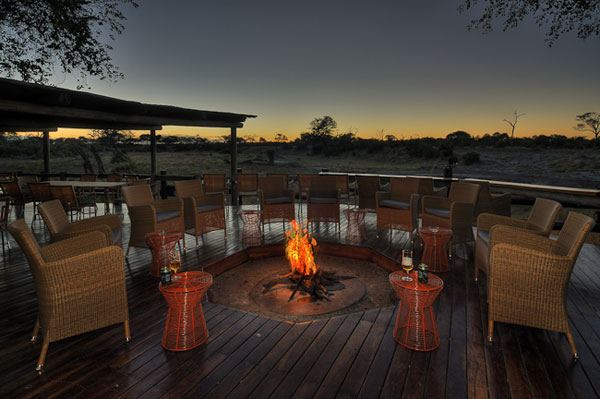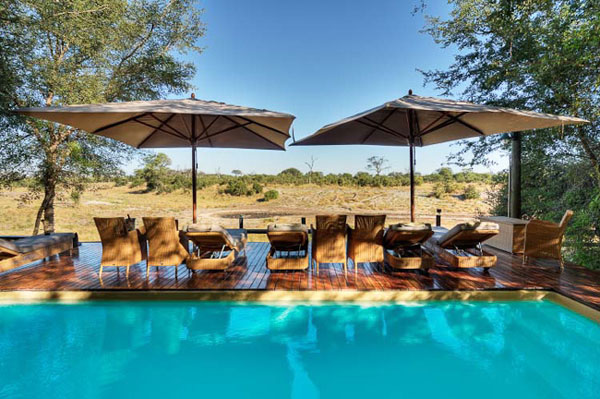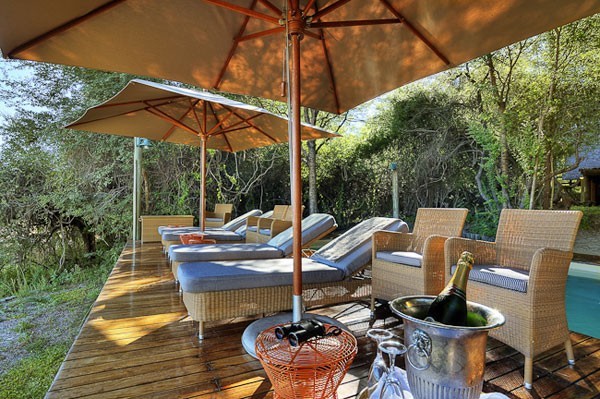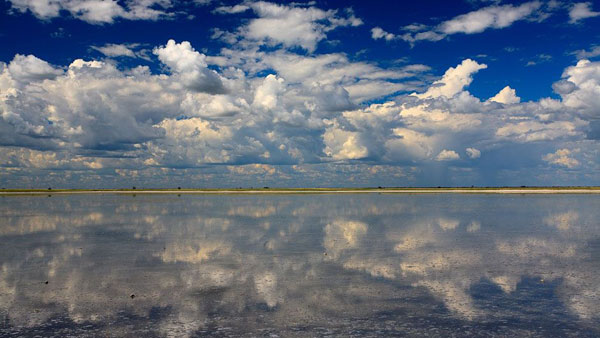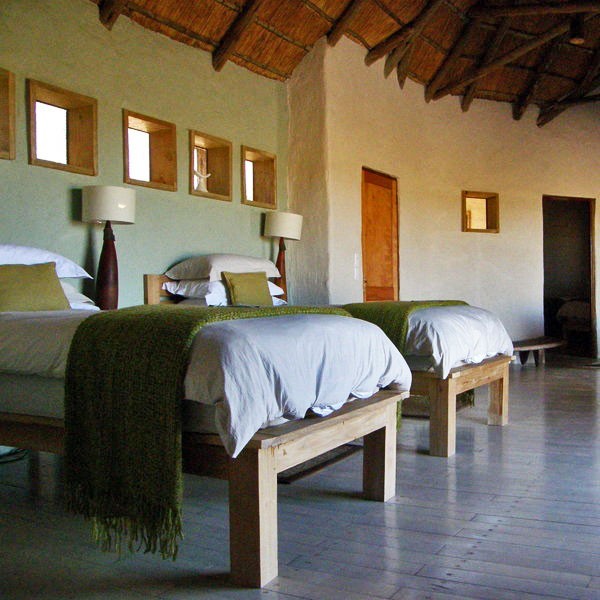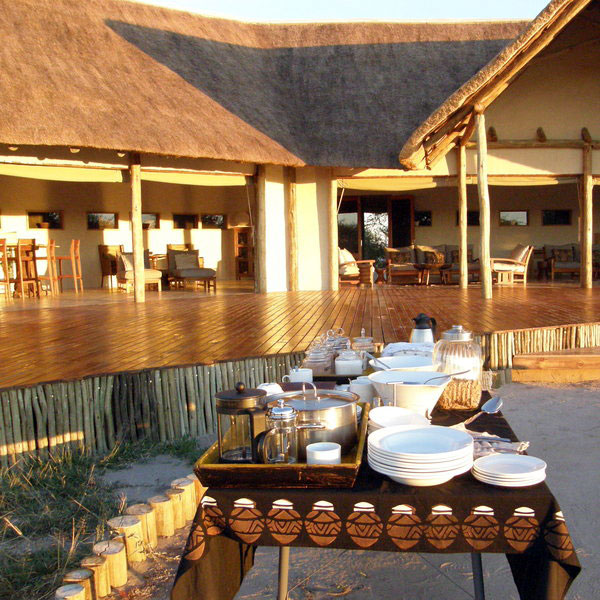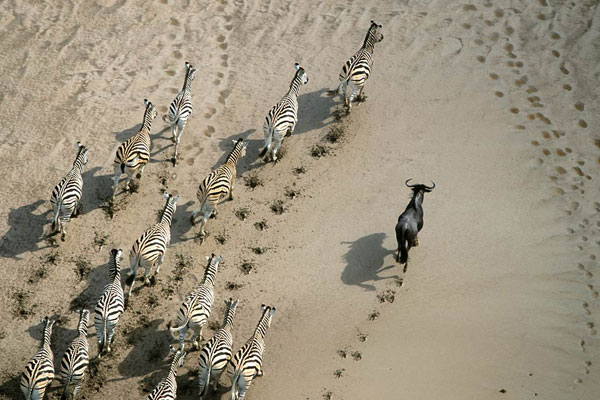The Makgadikgadi and Nxai Pan National Parks in Botswana depict a fossilised landscape of what used to be a vast lake. This majestic tract of land carried a colossal body of water up until about one thousand five hundred years ago when it dried up and gave way to the crystallised salt pans that were once submerged lake-floors. Today this area is known for stark landscapes that stretch eternally outwards, only halting to meet the sky as the two join in their horizontal embrace. The harsh, arid environment of the Makgadikgadi is a place of sweltering heat and parched plains during the months of July to November, just preceding the rains brought about by summer. Visitors to the Makgadikgadi National Park are invited to observe in wonderment as the rains quench the scaled Pans and entice the attendance of thousands of plains game to graze on the short grasses and lap at the replenished waterholes.
Each year, at this festival of birth and rebirth, an astounding number of zebra begin their ancient southern migration through Botswana’s Makgadikgadi and Nxai Pan National Parks, originating in Boteti River in the North. This cyclical mass movement of up to twenty five thousand zebra has been taking place for decades; however, not without obstruction. This five hundred and eighty kilometre migration route that is repeated each year was interrupted by the erection of fences as early as the 1950s. This form of human encroachment caused the decline and ultimately, the cessation of the migrating herds altogether. Farmers set out to protect their livestock from diseases carried by wildlife, thereby building barriers that prevented the transmission of diseases, and inadvertently blockading the pathway so engrained in the history of this great trek.
The presence of the annual zebra migration through Botswana today is proof that the disruption of these innately woven routes has not defeated the instinctual move to follow the rains. Physical barricades and habitat fragmentation prompted the reworking of age-old routes, and staggered the fluidity of this circular route from the Okavango, through the Makgadikgadi and Nxai Pans; however, this ancestral movement holds strong, and can be relied upon to create a wildlife spectacle, second only to the great migration of the Serengeti.
This spectacular scene, made famous by the hoards of wildebeest and zebra crossing the borders between Tanzania’s Serengeti and Kenya’s Mara, is replicated in black and white abundance in Botswana. Safari-goers gather in this magnificent country to witness the unrivalled game activity present at all times of the year. The introduction of the rains is unmistakeably affiliated with the birth of zebra and springbok young in the Nxai Pan area, the chaotic rejoice of nourished land, and the eager anticipation of easy meals for stealthy predators. A game-viewing paradise relished by travellers is offered by safari camps dispersed amongst camelthorn acacias, in between waterholes and alongside riverbanks.
Savute Safari Lodge boasts an enviable position along the temperamental Savute Channel in the Chobe National Park. The area is alive with the jostling herds of zebra, following the scent of moist air as it leads them along learned routes. Accommodating just twenty four guests, Savute Safari Lodge maintains its discreet position peering through the woodland that surrounds the channel. From comfortable recliners placed elegantly on wooden decks, guests are invited to sip on refreshments and observe the scene that inevitably plays out beyond. Deep pools of cool adorn the decks, providing an appealing contrast to the heat, but without compromising on the view of the marsh. Savute Safari Lodge entices lazy mornings as large spacious interiors are spoiled with sunlight as the warmth of daybreak spills through glass panels and penetrates thatch roofs, sweetening the air. After humid November days, guests at this luxury lodge are led to dine and indulge as a mouth-watering spread of African cuisine is served amid the satisfied hum of an evening spent on safari.
Being spoilt for choice is often the case in the more frequented parts of Botswana; however, Nxai Pan National Park eliminates the room for error in offering only one permanent camp in which to accommodate its travellers. Nxai Pan Camp roots itself in the whitewashed, salty sand and spreads its vast wooden decks over dry surfaces, creating an understatedly stylish position from which is soak up the stark surroundings. When zebra mares bear their infant foals, it is here in the Nxai Pan National Park that these bleary-eyed babies take their first steps, and guests at Nxai Pan are offered prime viewing rights onto the permanent waterhole, which glistens before the camp’s main deck. Thick thatch and clay walls incubate against the winter chill, while the high ceilings and whitewashed floors keep the summer heat at bay, thereby insisting on comfort at any time of year.
The mysterious extravagance that epitomises Botswana’s salt pans is joined by the ritualistic rumble of an entire population of zebras moving only once every year, creating an unquestionable opportunity to break away from dreary norms and witness an episode of pure instinct. The recognition of the changing season in November is evident in the mass movement of many species; by land and by air, Botswana’s Makgadikgadi and Nxai Pan circuit vibrates with activity and presents to the bystander a safari experience to be remembered.
